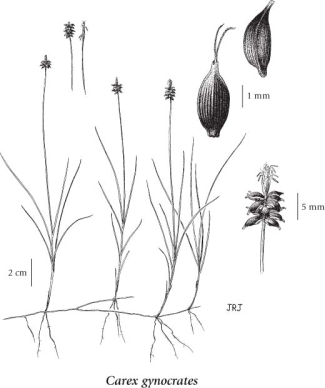Carex gynocrates Wormsk. ex Drejer
yellow bog sedge (northern bog sedge)
Cyperaceae (Sedge family)
Introduction to Vascular Plants
yellow bog sedge (northern bog sedge)
Cyperaceae (Sedge family)
Introduction to Vascular Plants
Species Information
General:
Perennial herb from long, slender rhizomes; stems 5-30 cm tall, single or a few together, longer than the leaves.
Leaves:
Sheaths tight; ligules wider than long; blades 3 to 5 per stem, narrowly in-rolled, borne on the lower 1/2 of the stem, about 0.5 mm wide, the lower ones persisting, reduced.
Flowers:
Spikes solitary, usually with both female and male flowers, the few male flowers towards the tips, sometimes the spikes with all male flowers or all female flowers, the male segment broadly cylindrical, the female segment egg-shaped, 5-15 mm long, 2-4 mm wide, erect; bractless.
Fruits:
Perigynia egg-shaped, 2.5-4 mm long, 1.5-2 mm wide, yellowish to brownish-black, inflated, shiny, finely and many nerved above, reflexed when ripe, short-stalked, the beaks faintly toothed, about 0.5 mm long, bidentate; female scales egg-shaped, shorter but wider than the perigynia, pointed, reddish-brown to brown, the centres lighter; stigmas 2; achenes lens-shaped, 1.2-1.5 mm long.
Illustration

If more than one illustration is available for a species (e.g., separate illustrations were provided for two subspecies) then links to the separate images will be provided below. Note that individual subspecies or varietal illustrations are not always available.
Illustration Source: The Illustrated Flora of British Columbia
Ecology
Ecological Framework for Carex gynocrates
The table below shows the species-specific information calculated from
original data (BEC database) provided by the BC Ministry of Forests and Range.
(Updated August, 2013)
The table below shows the species-specific information calculated from
original data (BEC database) provided by the BC Ministry of Forests and Range.
(Updated August, 2013)
| Site Information |
Value / Class |
||
|
Avg |
Min |
Max |
|
| Elevation
(metres) |
1065 | 7 | 2170 |
| Slope
Gradient (%) |
4 | 0 | 70 |
|
Aspect (degrees) |
265 | 20 | 360 |
| Soil
Moisture Regime (SMR) [0 - very xeric; 4 - mesic; 8 - hydric] |
6 | 2 | 8 |
| Modal
Nutrient Regime
Class |
b | ||
| #
of field plots species was recorded in: |
137 | ||
| Modal
BEC Zone Class |
BWBS | ||
|
All BEC Zones (# of stations/zone) species was recorded in |
BAFA(1), BWBS(46), CWH(2), ESSF(22), ICH(5), IDF(4), MH(3), MS(9), SBPS(1), SBS(22), SWB(7) | ||
|
Source:
Klinkenberg 2013
|
|||
Habitat and Range
Bogs, swamps, fens and wet meadows in the upper montane to alpine zones; common in BC in and E of the Coast-Cascade Mountains; amphiberingian, N to AK, YT and NT, E to NF and S to MA, PA, MN, MI, ND, CO, UT, NV and OR; Greenland, E Asia.Status Information
Synonyms
Synonyms and Alternate Names:
Carex dioica subsp. gynocrates (Wormsk. ex Drejer) HultΘn
Carex dioica var. gynocrates (Wormsk. ex Drej.) Ostenf.
Carex parallela (Laest.) Sommerf.